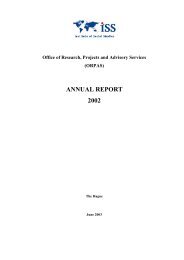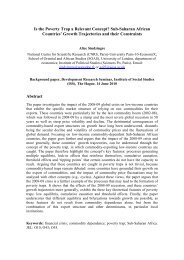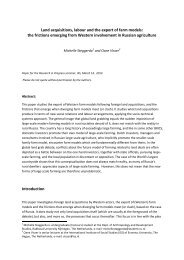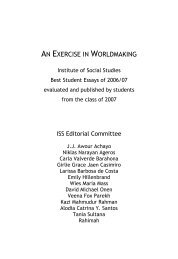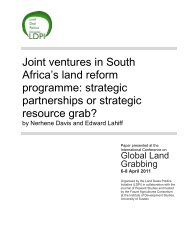AN EXERCISE IN WORLDMAKING 2009 - ISS
AN EXERCISE IN WORLDMAKING 2009 - ISS
AN EXERCISE IN WORLDMAKING 2009 - ISS
Create successful ePaper yourself
Turn your PDF publications into a flip-book with our unique Google optimized e-Paper software.
9 Tailoring Credit Programs along the Logic of the Poor 97<br />
logic of the former and recommend realistic poverty alleviation strategies<br />
to increase the security of the very poor.<br />
This paper attempts to contribute to the discourse by making the case<br />
that understanding the logic of the poor is critical to their inclusion in<br />
microfinance programs. Various microfinance solutions tailored for the<br />
very poor, and their accompanying trade-offs, are presented through innovations<br />
found in the literature. The paper concludes by highlighting<br />
the need to put development back into microfinance, to tailor it as a<br />
poverty alleviation instrument more than a profit-making enterprise.<br />
Microfinance programs as a tool for urban poverty alleviation are perceived<br />
as more than technical activities geared towards product-related<br />
‘hard issues’ (technological, financial, physical and material, in Botes and<br />
van Rensburg, 2000: 46-47). Such interventions are considered political<br />
activities that view process-related ‘soft issues’ as an endogenous aspect<br />
of the developmental process. ‘Soft issues’ refer to community involvement,<br />
decision-making procedures, organizational development for capacity<br />
building, and related processes.<br />
Figure 1 is an analytical framework illustrating the concepts and arguments<br />
in this paper.<br />
THE POTENCY OF MICROF<strong>IN</strong><strong>AN</strong>CE<br />
The potency of microfinance has been much debated: as a single intervention,<br />
it can be sold to any government and regime as it is widely considered<br />
a cost-neutral way to reduce poverty. Yet this presumed costneutrality<br />
is criticized, particularly with regard to credit programs subsidized<br />
by government to benefit the poor. If the poorest mostly cannot<br />
benefit from microcredit, Eversole (2000) argues, then it is the less poor<br />
who do.<br />
Mosley and Hulme (1998: 783-784) observe that by lending to the uncollateralized<br />
poor, financial institutions have attained higher rates of<br />
loan recovery than commercial banks, and that apparently, a ‘reliable organizational<br />
technology for lending to the poor of developing countries<br />
now exists’. However, they argue that the assumption that this technology<br />
reduces poverty has rarely been tested, apart from studies by the<br />
Grameen Bank. To address the gap, a study assessed the impact of 13<br />
MFIs in seven developing countries (Bangladesh, Bolivia, India, Indonesia,<br />
Kenya, Malawi and Sri Lanka). The findings indicated that the poor<br />
preferred consumption loans, economic shocks made them more vulner-




